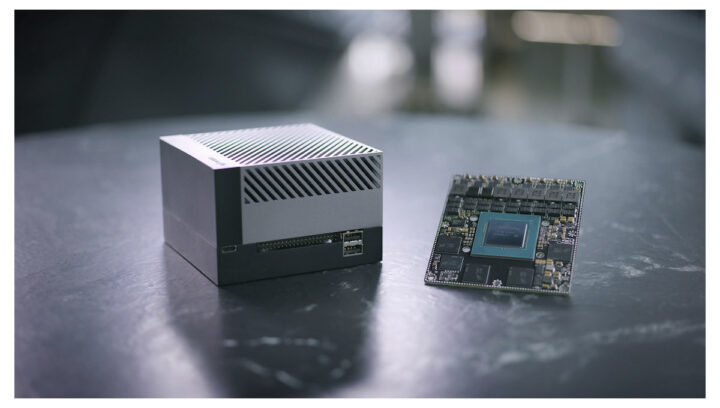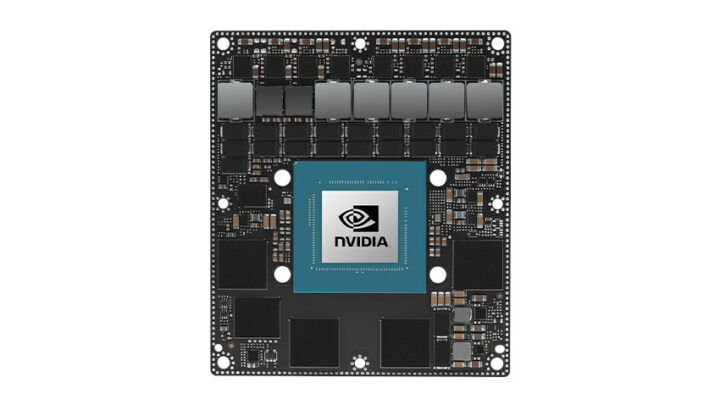The upcoming NVIDIA Jetson AGX Orin module packs some serious processing power with a 12-core Cortex-A78AE processor, 2048 CUDA cores, and 64 Tensor cores delivering up to 200 TOPS of AI performance, or 6 times more than its predecessor, the Jetson AGX Xavier module.
Designed for robotics, autonomous machines, medical devices, the Jetson AGX Orin delivers the same performance as a GPU-enabled server, but in a much more compact 100 x 87mm form factor. The module can be operated in three power modes, namely 15W, 30W, or 50W depending on performance and power requirements, and a compact developer kit will also be made available.
 Jetson AGX Orin specifications:
Jetson AGX Orin specifications:
- CPU – 12-core Arm Cortex-A78AE v8.2 64-bit processor with 3MB L2 + 6MB L3 cache
- GPU / AI accelerators
- NVIDIA Ampere architecture with 2048 NVIDIA CUDA cores and 64 Tensor Cores @ 1 GHz
- DL Accelerator – 2x NVDLA v2.0
- Vision Accelerator – PVA v2.0 (Programmable Vision Accelerator)
- AI Performance – 200 TOPS (INT8) @ 50W
- Video Encode – 2x 4K60 | 4x 4K30 | 8x 1080p60 | 16x 1080p30 (H.265)
- Video Decode – 1x 8K30 | 3x 4K60 | 6x 4K30 | 12x 1080p60| 24x 1080p30 (H.265)
- System Memory – 32GB 256-bit LPDDR5 @ 204.8 GB/s
- Storage – 64GB eMMC 5.1 flash
- 699-pin Molex Mirror Mezz connector with
- Storage – Single lane UFS
- Display – 1x 8K60 multi-mode DP 1.4a (+MST), eDP 1.4a, HDMI 2.1
- Camera
- Up to 6x CSI Camera (16 via virtual channels)
- 16 lanes MIPI CSI-2
- D-PHY 1.2 (up to 40Gbps) | C-PHY 1.1 (up to 164Gbps)
- Networking – 1x GbE, 4x 10GbE
- PCIe – 2x PCIe x8 (or 1x PCIe x8 + 2x PCIe x4), 1x PCIe x4, 2x PCIe x1 (PCIe Gen4, Root Port & Endpoint)
- USB – 3x USB 3.2, 4x USB 2.0
- Low speed IOs – 4x UART, 3x SPI, 4x I2S, 8x I2C, 2x CAN, DMIC & DSPK, GPIOs
- Power Modes – 15W, 30W, or 50W
- Dimensions – 100 x 87mm
 The module will come with an integrated thermal transfer plate, is pin-to-pin compatible with Jetson AGX Xavier meaning most existing carrier boards should still work, and relies on the same NVIDIA JetPack and NVIDIA AI software tools such as the TAO toolkit. There will also be a DRIVE AGX Orin based on the same SoC and specifically designed for the automotive market.
The module will come with an integrated thermal transfer plate, is pin-to-pin compatible with Jetson AGX Xavier meaning most existing carrier boards should still work, and relies on the same NVIDIA JetPack and NVIDIA AI software tools such as the TAO toolkit. There will also be a DRIVE AGX Orin based on the same SoC and specifically designed for the automotive market.
NVIDIA Jetson AGX Orin module and developer kit should become available in Q1 2022, but the company did not release any pricing information yet. Considering the NVIDIA Jetson AGX Xavier devkit used to sell for $699, I’d expect a price tag over $1,000 for the Orin development kit. Details are limited at this time, but you can find additional information in the press release, and on the product page where you can also register to get notified of availability.

Jean-Luc started CNX Software in 2010 as a part-time endeavor, before quitting his job as a software engineering manager, and starting to write daily news, and reviews full time later in 2011.
Support CNX Software! Donate via cryptocurrencies, become a Patron on Patreon, or purchase goods on Amazon or Aliexpress. We also use affiliate links in articles to earn commissions if you make a purchase after clicking on those links.




I guess this will be the chip of the next Nintendo Switch.
Probably will be cut down a bit, but would be nice.
Keep dreaming, unless next nintendo switch is going to cost $800, I don’t see this happening.
Doubt this device suits Switch needs, Switch is stuck between mobile phone SoC and Steam handheld, Plus a wiff of Apple M1.
It is a watch and see situation.
Well, they are currently building a lot of fabs. So, I think we are going to see a huge price drop in 2023/2024.
Fair, it does have a lot of features that would be useless on a console.
Still, I hope it points towards the Switch 2 having at least A78 equivalent cores, preferably clocked high.
Nothing about this SoC costs $800. The price tag will be high for AGX Orin because it’s an industrial/enterprise product.
A Switch 2 could absolutely get one of these, probably with the GPU cut in half or something like that.
Impressive. I wonder if they are backward compatible with Xavier so that I could just replace the module itself and not touch backplane.
Maybe it would help to read the article 🙂
It says “most” and “should”, and knowing my luck, mine will fall exactly in that “all” minus “most” gap.
I find it difficult to imagine the potential applications with so much power.
If I read correctly Level 4/5 autonomous driving might be possible at this level of performance.
“640Kb RAM should be enough for everyone”
Is this being manufactured on Samsung 8nm?
I wonder how Nintendo is going to approach their next console in the SoC department. After Tegra X1, all Tegras werent made for tablets market and have a lot of features that doesnt make sense on a portable console.
Oh probably they’ll add a big fat external connector that you’re supposed to use to connect to your bike’s battery pack, and two other holes to deliver hot water in exchange for cool water, pretending you can use that to heat up your meal during a pause in a bike trail 🙂
It says the current module, as-is, can run on as low as 10W. If the core count and a few bells and whistles are removed, it could absolutely be kept within a switch’s power envelope
https://www.youtube.com/watch?v=cUJtIK94Djc
‘System Memory – 32GB 256-bit LPDDR5 @ 204.8 GB/s’
204.8 GB/s between cpu (Cortex A78AE) cores and memory, also?
Anyway, astonishing improvements
I think so. That’s DDR5-6400 in 256 bits, or roughly 4 times the bandwidth of a dual-channel x86 PC. I think this monster might even find usages that do not directly involve the NPU (data mining etc for example).
Looks nice, dunno about the heat this produce, but i would love to see a cpu like this in something like a surface laptop
Okay, how to get one if you are from.. just poor???
The final product for this type of module is likely a factor of magnitude more expensive than the module itself, think cars. robots, factories, etc…
I wonder if there will be more budget models: a Jetson Orin NX or an updated Jetson Nano (and when).
I want one, lol, but I recently upgraded to Ryzen 5700g, so I will have to curb my enthusiasm as my partner will kill me if I clutter this place up with more PC hardware.
You’ll just have to demonstrate that it’s totally different from a PC. You could use it to detect movements on cameras for example, and do plenty of other tasks the rest of the time 🙂
How are you liking it? I’m looking forward to the Rembrandt version of that instead.
NVIDIA has removed UFS support from Jetson Orin:
https://forums.developer.nvidia.com/t/how-to-enable-ufs-based-on-jetson-agx-orin-developer-kit/252559